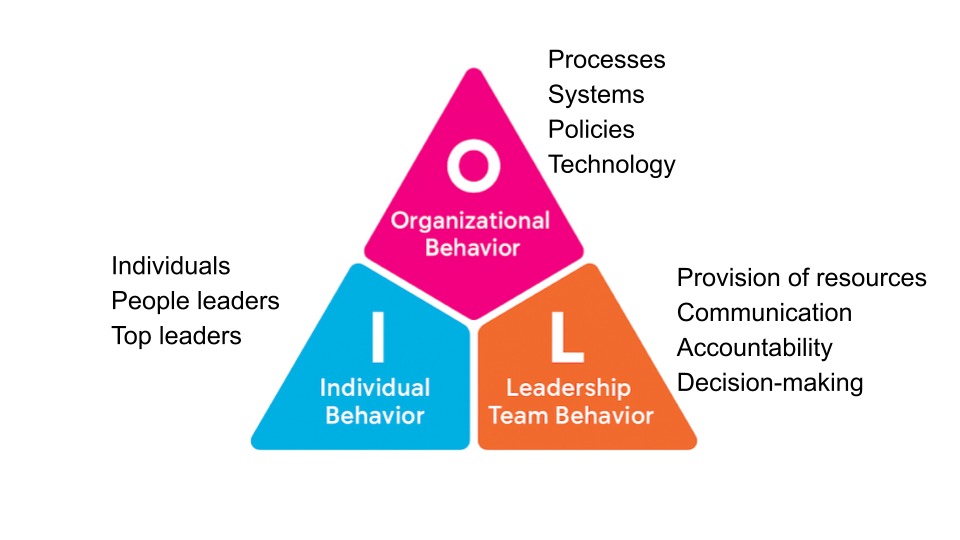We all want a workplace where people feel seen, heard, and valued. But building that kind of culture takes more than good intentions and inspirational posters. It demands a clear-eyed look at how people behave, how leaders lead, and how the organization itself either supports or hinders inclusivity and respect.
At Civility Partners, we know that a great workplace culture doesn’t evolve by accident. It requires structure, consistency, and alignment across every level of the organization. To help you, and our clients, develop clear and high-impact strategies to build and sustain respectful and positive culture, we created the OIL Model of Culture Change.
It’s a simple yet powerful framework to help you evaluate whether your culture is reinforcing the values it claims to stand for or quietly enabling behaviors that chip away at trust and inclusion.
Use this model to start making real, lasting change.
The OIL That Fuels Culture Change
OIL stands for Organizational Behavior, Individual Behavior, and Leadership Team Behavior. These are the three pillars of your workplace culture. When they’re aligned and healthy, respect and inclusivity naturally flourish. When they’re misaligned, that’s when we see issues like disengagement, turnover, workplace bullying, or harassment creep in.
Let’s break down each component:
1. Organizational Behavior
Organizational behavior refers to the systems, processes, policies, and tools that influence individual behavior and the resulting employee experience. From how performance is evaluated to how core values are operationalized, this is the infrastructure that either supports or undermines a respectful, inclusive culture.
Leaders committed to culture ensure that the organization itself is behaving in ways that influence individual behavior in the right ways.
Let’s say an organization has a core value related to learning and growth but expects its people to cram everything they need to do into a very long workweek. People can’t learn and grow when they’re burned out or don’t have time to debrief on learning moments—so the organization’s behavior is not in alignment with the behavior it claims to seek from its workforce.
2. Individual Behavior
Individual behavior refers to how each and every individual at any level shows up to the workplace day in and day out. It includes how employees interact with one another, how managers lead, and how leaders model values. Every individual plays a role in shaping culture through their word choice, body language, tone, mindset, and actions.
The catch is that the organization’s behavior influences individual behavior. Organizations can offer training and ensure performance management measures and rewards for people engaging in the right behavior and that they don’t tolerate behavior that goes against organizational goals. Of course, leaders have to be willing to put resources towards initiatives that drive the right behavior.
3. Leadership Team Behavior
While each top leader’s individual behavior is important, this third pillar is about how the leaders’ function as a team. It includes the C-suite (CEO, CFO, COO, etc.), HR, department heads, or regional leaders—anyone with influence over how culture is shaped and sustained.
Leader actions speak volumes. The way they communicate about initiatives, allocate resources, and hold others accountable sets the tone. If leaders want individuals to act in ways that benefit the business, they need to ensure the organization’s behavior is in alignment with those goals, and of course that means they must lead with intention and invest time, energy, and budget into making it real.
When the OIL is Aligned or Misaligned
When these three areas—organizational, individual, and leadership behavior—are aligned, the organization is more likely to have a strong culture. For example, if an organization determines it wants a respectful workplace, it must create systems and processes (i.e., organizational behavior) that influence that behavior for accountability, and the leaders will need to allocate resources to that endeavor.
If the organization determines it wants a respectful workplace, but its behavior doesn’t align (e.g., results are valued over the way people are treated, no one is measured on respect, clients are allowed to be disrespectful to employees) because leaders aren’t willing to allocate the resources, then individuals won’t behave in ways that build a respectful culture.
What Now?
Disrespect, exclusion, bullying, and disengagement don’t happen by accident. The truth is, even the most well-meaning organizations can fall short if they’re not actively assessing their culture across all three OIL pillars. The three pillars have to align for you to reach the desired culture.
Ask yourself these three questions, and discuss them with your leadership team:
- How do we want each individual to behave?
- What does the organization do or not do that helps or hinders that behavior?
- What are the leaders doing or not doing that helps or hinders that behavior?
Be sure to bring this OIL Model Assessment with you to that conversation. You and your leadership team can pause, reflect, and evaluate whether your organization is fostering the kind of workplace it aspires to be. The OIL Model Assessment is a meaningful, action-oriented resource designed to prompt honest reflection and spark important conversations with your leadership team.
Last week, we held the virtual book launch party for Navigating a Toxic Work Environment for Dummies. Here’s what Garry Ridge, retired CEO of WD-40, said about the book:



